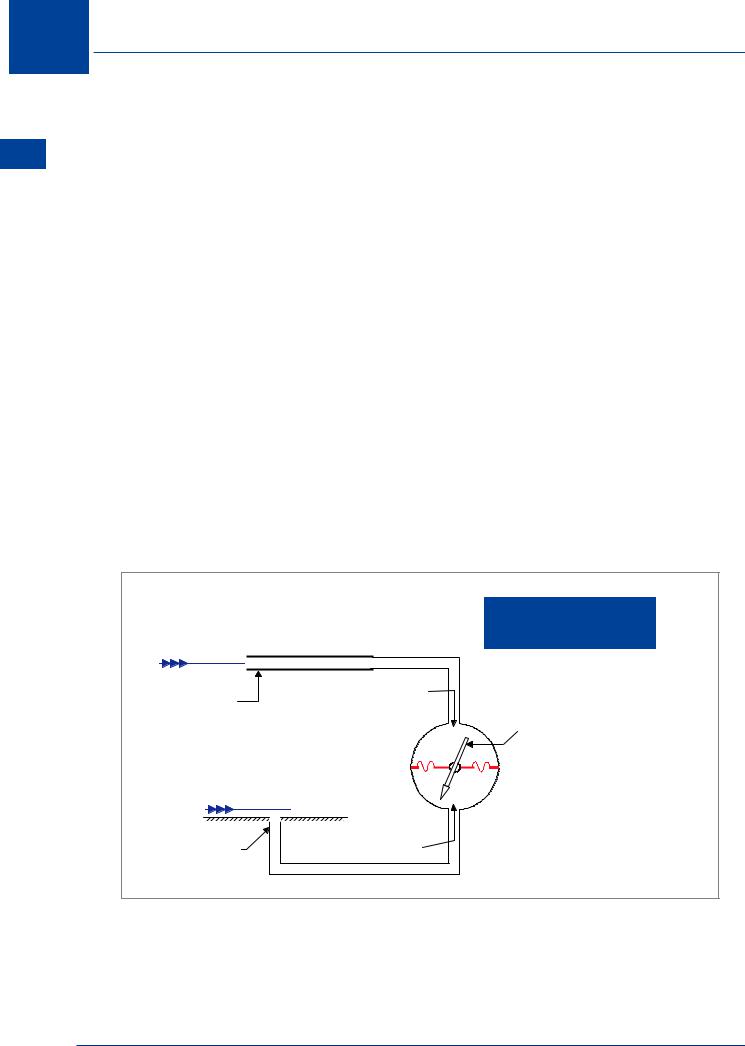
- •Textbook Series
- •Contents
- •1 Overview and Definitions
- •Overview
- •General Definitions
- •Glossary
- •List of Symbols
- •Greek Symbols
- •Others
- •Self-assessment Questions
- •Answers
- •2 The Atmosphere
- •Introduction
- •The Physical Properties of Air
- •Static Pressure
- •Temperature
- •Air Density
- •International Standard Atmosphere (ISA)
- •Dynamic Pressure
- •Key Facts
- •Measuring Dynamic Pressure
- •Relationships between Airspeeds
- •Airspeed
- •Errors and Corrections
- •V Speeds
- •Summary
- •Questions
- •Answers
- •3 Basic Aerodynamic Theory
- •The Principle of Continuity
- •Bernoulli’s Theorem
- •Streamlines and the Streamtube
- •Summary
- •Questions
- •Answers
- •4 Subsonic Airflow
- •Aerofoil Terminology
- •Basics about Airflow
- •Two Dimensional Airflow
- •Summary
- •Questions
- •Answers
- •5 Lift
- •Aerodynamic Force Coefficient
- •The Basic Lift Equation
- •Review:
- •The Lift Curve
- •Interpretation of the Lift Curve
- •Density Altitude
- •Aerofoil Section Lift Characteristics
- •Introduction to Drag Characteristics
- •Lift/Drag Ratio
- •Effect of Aircraft Weight on Minimum Flight Speed
- •Condition of the Surface
- •Flight at High Lift Conditions
- •Three Dimensional Airflow
- •Wing Terminology
- •Wing Tip Vortices
- •Wake Turbulence: (Ref: AIC P 072/2010)
- •Ground Effect
- •Conclusion
- •Summary
- •Answers from page 77
- •Answers from page 78
- •Questions
- •Answers
- •6 Drag
- •Introduction
- •Parasite Drag
- •Induced Drag
- •Methods of Reducing Induced Drag
- •Effect of Lift on Parasite Drag
- •Aeroplane Total Drag
- •The Effect of Aircraft Gross Weight on Total Drag
- •The Effect of Altitude on Total Drag
- •The Effect of Configuration on Total Drag
- •Speed Stability
- •Power Required (Introduction)
- •Summary
- •Questions
- •Annex C
- •Answers
- •7 Stalling
- •Introduction
- •Cause of the Stall
- •The Lift Curve
- •Stall Recovery
- •Aircraft Behaviour Close to the Stall
- •Use of Flight Controls Close to the Stall
- •Stall Recognition
- •Stall Speed
- •Stall Warning
- •Artificial Stall Warning Devices
- •Basic Stall Requirements (EASA and FAR)
- •Wing Design Characteristics
- •The Effect of Aerofoil Section
- •The Effect of Wing Planform
- •Key Facts 1
- •Super Stall (Deep Stall)
- •Factors that Affect Stall Speed
- •1g Stall Speed
- •Effect of Weight Change on Stall Speed
- •Composition and Resolution of Forces
- •Using Trigonometry to Resolve Forces
- •Lift Increase in a Level Turn
- •Effect of Load Factor on Stall Speed
- •Effect of High Lift Devices on Stall Speed
- •Effect of CG Position on Stall Speed
- •Effect of Landing Gear on the Stall Speed
- •Effect of Engine Power on Stall Speed
- •Effect of Mach Number (Compressibility) on Stall Speed
- •Effect of Wing Contamination on Stall Speed
- •Warning to the Pilot of Icing-induced Stalls
- •Stabilizer Stall Due to Ice
- •Effect of Heavy Rain on Stall Speed
- •Stall and Recovery Characteristics of Canards
- •Spinning
- •Primary Causes of a Spin
- •Phases of a Spin
- •The Effect of Mass and Balance on Spins
- •Spin Recovery
- •Special Phenomena of Stall
- •High Speed Buffet (Shock Stall)
- •Answers to Questions on Page 173
- •Key Facts 2
- •Questions
- •Key Facts 1 (Completed)
- •Key Facts 2 (Completed)
- •Answers
- •8 High Lift Devices
- •Purpose of High Lift Devices
- •Take-off and Landing Speeds
- •Augmentation
- •Flaps
- •Trailing Edge Flaps
- •Plain Flap
- •Split Flap
- •Slotted and Multiple Slotted Flaps
- •The Fowler Flap
- •Comparison of Trailing Edge Flaps
- •and Stalling Angle
- •Drag
- •Lift / Drag Ratio
- •Pitching Moment
- •Centre of Pressure Movement
- •Change of Downwash
- •Overall Pitch Change
- •Aircraft Attitude with Flaps Lowered
- •Leading Edge High Lift Devices
- •Leading Edge Flaps
- •Effect of Leading Edge Flaps on Lift
- •Leading Edge Slots
- •Leading Edge Slat
- •Automatic Slots
- •Disadvantages of the Slot
- •Drag and Pitching Moment of Leading Edge Devices
- •Trailing Edge Plus Leading Edge Devices
- •Sequence of Operation
- •Asymmetry of High Lift Devices
- •Flap Load Relief System
- •Choice of Flap Setting for Take-off, Climb and Landing
- •Management of High Lift Devices
- •Flap Extension Prior to Landing
- •Questions
- •Annexes
- •Answers
- •9 Airframe Contamination
- •Introduction
- •Types of Contamination
- •Effect of Frost and Ice on the Aircraft
- •Effect on Instruments
- •Effect on Controls
- •Water Contamination
- •Airframe Aging
- •Questions
- •Answers
- •10 Stability and Control
- •Introduction
- •Static Stability
- •Aeroplane Reference Axes
- •Static Longitudinal Stability
- •Neutral Point
- •Static Margin
- •Trim and Controllability
- •Key Facts 1
- •Graphic Presentation of Static Longitudinal Stability
- •Contribution of the Component Surfaces
- •Power-off Stability
- •Effect of CG Position
- •Power Effects
- •High Lift Devices
- •Control Force Stability
- •Manoeuvre Stability
- •Stick Force Per ‘g’
- •Tailoring Control Forces
- •Longitudinal Control
- •Manoeuvring Control Requirement
- •Take-off Control Requirement
- •Landing Control Requirement
- •Dynamic Stability
- •Longitudinal Dynamic Stability
- •Long Period Oscillation (Phugoid)
- •Short Period Oscillation
- •Directional Stability and Control
- •Sideslip Angle
- •Static Directional Stability
- •Contribution of the Aeroplane Components.
- •Lateral Stability and Control
- •Static Lateral Stability
- •Contribution of the Aeroplane Components
- •Lateral Dynamic Effects
- •Spiral Divergence
- •Dutch Roll
- •Pilot Induced Oscillation (PIO)
- •High Mach Numbers
- •Mach Trim
- •Key Facts 2
- •Summary
- •Questions
- •Key Facts 1 (Completed)
- •Key Facts 2 (Completed)
- •Answers
- •11 Controls
- •Introduction
- •Hinge Moments
- •Control Balancing
- •Mass Balance
- •Longitudinal Control
- •Lateral Control
- •Speed Brakes
- •Directional Control
- •Secondary Effects of Controls
- •Trimming
- •Questions
- •Answers
- •12 Flight Mechanics
- •Introduction
- •Straight Horizontal Steady Flight
- •Tailplane and Elevator
- •Balance of Forces
- •Straight Steady Climb
- •Climb Angle
- •Effect of Weight, Altitude and Temperature.
- •Power-on Descent
- •Emergency Descent
- •Glide
- •Rate of Descent in the Glide
- •Turning
- •Flight with Asymmetric Thrust
- •Summary of Minimum Control Speeds
- •Questions
- •Answers
- •13 High Speed Flight
- •Introduction
- •Speed of Sound
- •Mach Number
- •Effect on Mach Number of Climbing at a Constant IAS
- •Variation of TAS with Altitude at a Constant Mach Number
- •Influence of Temperature on Mach Number at a Constant Flight Level and IAS
- •Subdivisions of Aerodynamic Flow
- •Propagation of Pressure Waves
- •Normal Shock Waves
- •Critical Mach Number
- •Pressure Distribution at Transonic Mach Numbers
- •Properties of a Normal Shock Wave
- •Oblique Shock Waves
- •Effects of Shock Wave Formation
- •Buffet
- •Factors Which Affect the Buffet Boundaries
- •The Buffet Margin
- •Use of the Buffet Onset Chart
- •Delaying or Reducing the Effects of Compressibility
- •Aerodynamic Heating
- •Mach Angle
- •Mach Cone
- •Area (Zone) of Influence
- •Bow Wave
- •Expansion Waves
- •Sonic Bang
- •Methods of Improving Control at Transonic Speeds
- •Questions
- •Answers
- •14 Limitations
- •Operating Limit Speeds
- •Loads and Safety Factors
- •Loads on the Structure
- •Load Factor
- •Boundary
- •Design Manoeuvring Speed, V
- •Effect of Altitude on V
- •Effect of Aircraft Weight on V
- •Design Cruising Speed V
- •Design Dive Speed V
- •Negative Load Factors
- •The Negative Stall
- •Manoeuvre Boundaries
- •Operational Speed Limits
- •Gust Loads
- •Effect of a Vertical Gust on the Load Factor
- •Effect of the Gust on Stalling
- •Operational Rough-air Speed (V
- •Landing Gear Speed Limitations
- •Flap Speed Limit
- •Aeroelasticity (Aeroelastic Coupling)
- •Flutter
- •Control Surface Flutter
- •Aileron Reversal
- •Questions
- •Answers
- •15 Windshear
- •Introduction (Ref: AIC 84/2008)
- •Microburst
- •Windshear Encounter during Approach
- •Effects of Windshear
- •“Typical” Recovery from Windshear
- •Windshear Reporting
- •Visual Clues
- •Conclusions
- •Questions
- •Answers
- •16 Propellers
- •Introduction
- •Definitions
- •Aerodynamic Forces on the Propeller
- •Thrust
- •Centrifugal Twisting Moment (CTM)
- •Propeller Efficiency
- •Variable Pitch Propellers
- •Power Absorption
- •Moments and Forces Generated by a Propeller
- •Effect of Atmospheric Conditions
- •Questions
- •Answers
- •17 Revision Questions
- •Questions
- •Answers
- •Explanations to Specimen Questions
- •Specimen Examination Paper
- •Answers to Specimen Exam Paper
- •Explanations to Specimen Exam Paper
- •18 Index

The Atmosphere 2
The temperature lapse rate is assumed to be uniform at a rate of 2°C per 1000 ft (1.98°C) from mean sea level up to a height of 36 090 ft (11 000 m) above which the lapse rate becomes zero and the temperature remains constant at -56.5°C.
ICAO Standard Atmosphere
Altitude |
Temperature |
Pressure (hPa) |
Density (kg/m3) |
Relative Density |
(ft) |
(°C) |
(p) |
(ρ) |
(σ) |
50 000 |
- 56.5 |
116.0 |
0.186 |
0.15 |
|
|
|
|
|
45 000 |
- 56.5 |
147.5 |
0.237 |
0.19 |
|
|
|
|
|
40 000 |
- 56.5 |
187.6 |
0.302 |
0.25 |
|
|
|
|
|
35 000 |
- 54.3 |
238.4 |
0.386 |
0.31 |
|
|
|
|
|
30 000 |
- 44.4 |
300.9 |
0.458 |
0.37 |
|
|
|
|
|
25 000 |
- 34.5 |
376.0 |
0.549 |
0.45 |
|
|
|
|
|
20 000 |
- 24.6 |
465.6 |
0.653 |
0.53 |
|
|
|
|
|
15 000 |
- 14.7 |
571.8 |
0.771 |
0.63 |
|
|
|
|
|
10 000 |
- 4.8 |
696.8 |
0.905 |
0.74 |
|
|
|
|
|
5000 |
5.1 |
843.1 |
1.056 |
0.86 |
|
|
|
|
|
Sea Level |
15 |
1013.25 |
1.225 |
1.0 |
|
|
|
|
|
The Atmosphere 2
NOTE: High Density Altitude means that the conditions that actually exist at the airport of takeoff or landing represent those of a higher altitude in the International Standard Atmosphere i.e. less air density.
Dynamic Pressure
The unit for dynamic pressure is N/m2 and the symbol is lower case ‘q’ or upper case ‘Q’.
•Because air has mass, air in motion must possess kinetic energy, and will exert a force per square metre on any object in its path. (KE = ½ m V2)
•It is called DYNAMIC pressure because the air is moving in relation to the object being considered, in this case an aircraft.
•Dynamic pressure is proportional to the density of the air and the square of the speed of the air flowing over the aircraft.
An aircraft immersed in moving airflow will therefore experience both static AND dynamic pressure. (Remember, static pressure is always present).
27

2 The Atmosphere
Atmosphere The 2
The kinetic energy of one cubic metre of air moving at a stated speed is given by the formula:
Kinetic Energy = ½ ρ V2 joules
where ρ is the local air density in kg/m3 and V is the speed in m/s
If this cubic metre of moving air is completely trapped and brought to rest by means of an open-ended tube the total energy will remain constant, but by being brought completely to rest the kinetic energy will become pressure energy which, for all practical purposes, is equal to:
Dynamic Pressure = ½ ρ V2 N/m2
Consider air flowing at 52 m/s (100 kt) with a density of 1.225 kg/m3
(100 kt = 100 NM/h = 100 × 6080 ft/h = 608 000 ÷ 3.28 = 185 366 ÷ 60 ÷ 60 m/s = 52 m/s)
Dynamic pressure = 0.5 × 1.225 × 52 × 52 = 1656 N/m2 (16.56 hPa)
If speed is doubled, dynamic pressure will be four times greater
0.5 × 1.225 × 104 × 104 = 6625 N/m2 (66.25 hPa)
If the cross-sectional area of the tube is 1 m2 a force of ½ ρ V2 newtons will be generated.
(Force = Pressure × Area)
Dynamic pressure ( ½ ρ V2 ) is common to ALL aerodynamic forces and determines the air loads imposed on an aeroplane moving through the air.
The symbol for dynamic pressure ( ½ ρ V2 ) is q or Q
Q = ½ ρ V2
28

The Atmosphere 2
Key Facts
A pilot needs to know how much dynamic pressure is available, but dynamic pressure cannot be measured on its own because static pressure will always be present. The sum of static and dynamic pressure, in this context, is known as ‘Total’ pressure.
(Dynamic + Static pressure can also be referred to as Stagnation or Pitot pressure).
Total Pressure = Static Pressure + Dynamic Pressure
This can be re-arranged to show that:
Total Pressure - Static Pressure = Dynamic Pressure
The significance of dynamic pressure to the understanding of Principles of Flight cannot be overemphasized.
Because dynamic pressure is dependent upon air density and the speed of the aircraft through the air, it is necessary for students to fully appreciate the factors which affect air density.
•Temperature - increasing temperature decreases air density. Changes in air density due to air temperature are significant during all phases of flight.
•Static pressure - decreasing static pressure decreases air density. Changes in air density due to static pressure are significant during all phases of flight.
•Humidity - increasing humidity decreases air density. (The reason increasing humidity decreases air density is that the density of water vapour is about 5/8 that of dry air). Humidity is most significant during take-off and landing.
Increasing altitude will decrease air density because the effect of decreasing static pressure is more dominant than decreasing temperature.
The Atmosphere 2
29

2 The Atmosphere
Atmosphere The 2
Measuring Dynamic Pressure
All aerodynamic forces acting on an aircraft are determined by dynamic pressure, so it is essential to have some means of measuring dynamic pressure and presenting that information to the pilot.
A sealed tube, open at the forward end, is located where it will collect air when the aircraft is moving. The pressure in the tube (pitot tube) is Dynamic + Static and, in this context, is called “Pitot” pressure (because the air is inside the pitot tube).
Some way of ‘removing’ the static pressure from the pitot pressure must be found. A hole (vent) in a surface parallel to the airflow will sense static pressure. Referring to the diagram below, if the pressure from the pitot tube is fed to one side of a diaphragm mounted in a sealed case, and static pressure is fed to the other side, the two static pressures will cancel each other and the diaphragm movement will be influenced only by changes in dynamic pressure.
Movement of the diaphragm moves a pointer over a scale so that changes in dynamic pressure can be observed by the flight crew. But the instrument is calibrated at ISA sea level density, so the instrument will only give a ‘true’ indication of the speed of the aircraft through the air when the air density is 1.225 kg/m3.
This is not a problem because the pilot needs an indication of dynamic pressure, and this is what the instrument provides. The instrument is made in such a way that it indicates the square root of the dynamic pressure in nautical miles per hour (knots) or statute miles per hour (mph). So, if this “Indicated Airspeed” is doubled, the speed of the aircraft through the air will also be doubled.
|
|
The Airspeed Indicator |
|
|
|
is a pressure gauge |
|
Airflow |
|
|
|
PITOT TUBE |
PITOT PRESSURE |
Needle indicates |
|
(Static + Dynamic) |
|||
|
changes in |
||
|
|
||
|
|
DYNAMIC PRESSURE |
Airflow |
|
|
STATIC VENT |
STATIC |
|
PRESSURE |
||
|
Figure 2.1 Schematic of the airspeed indicator (ASI)
30
